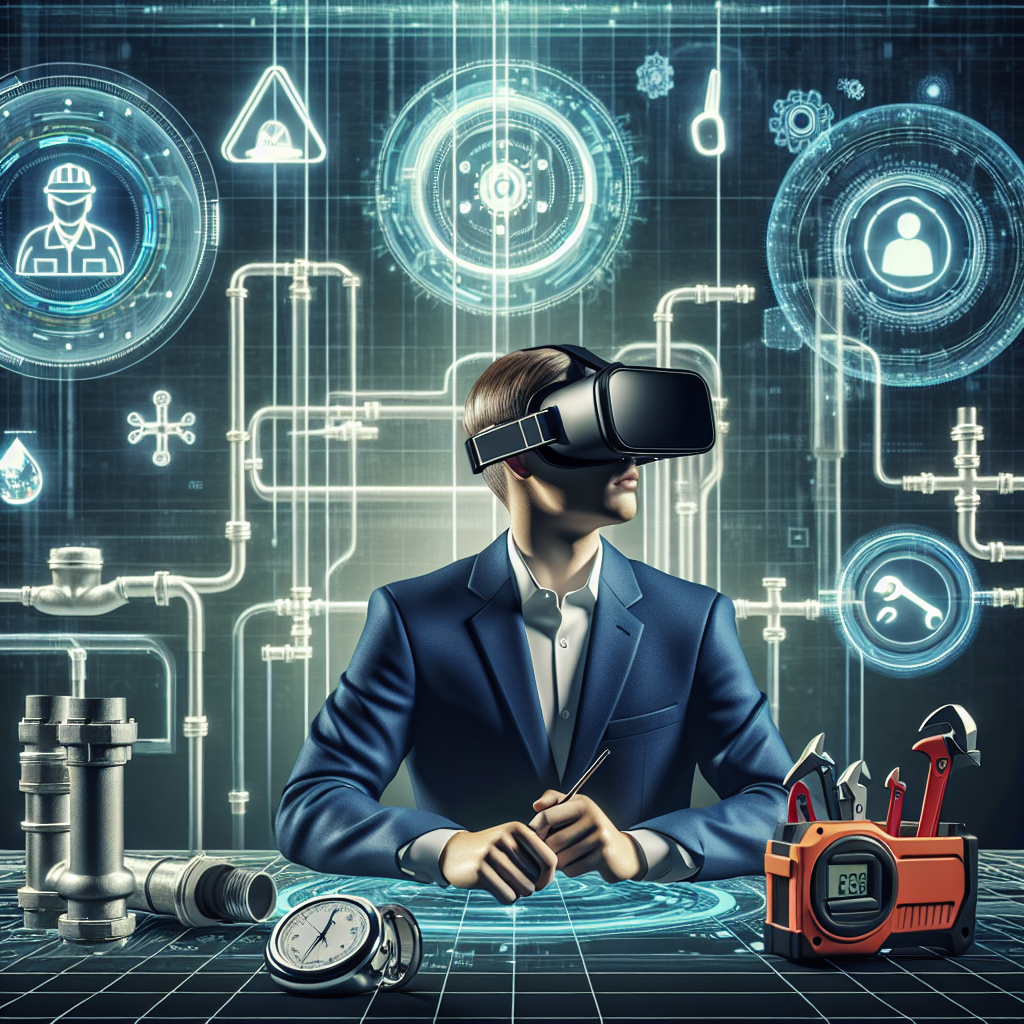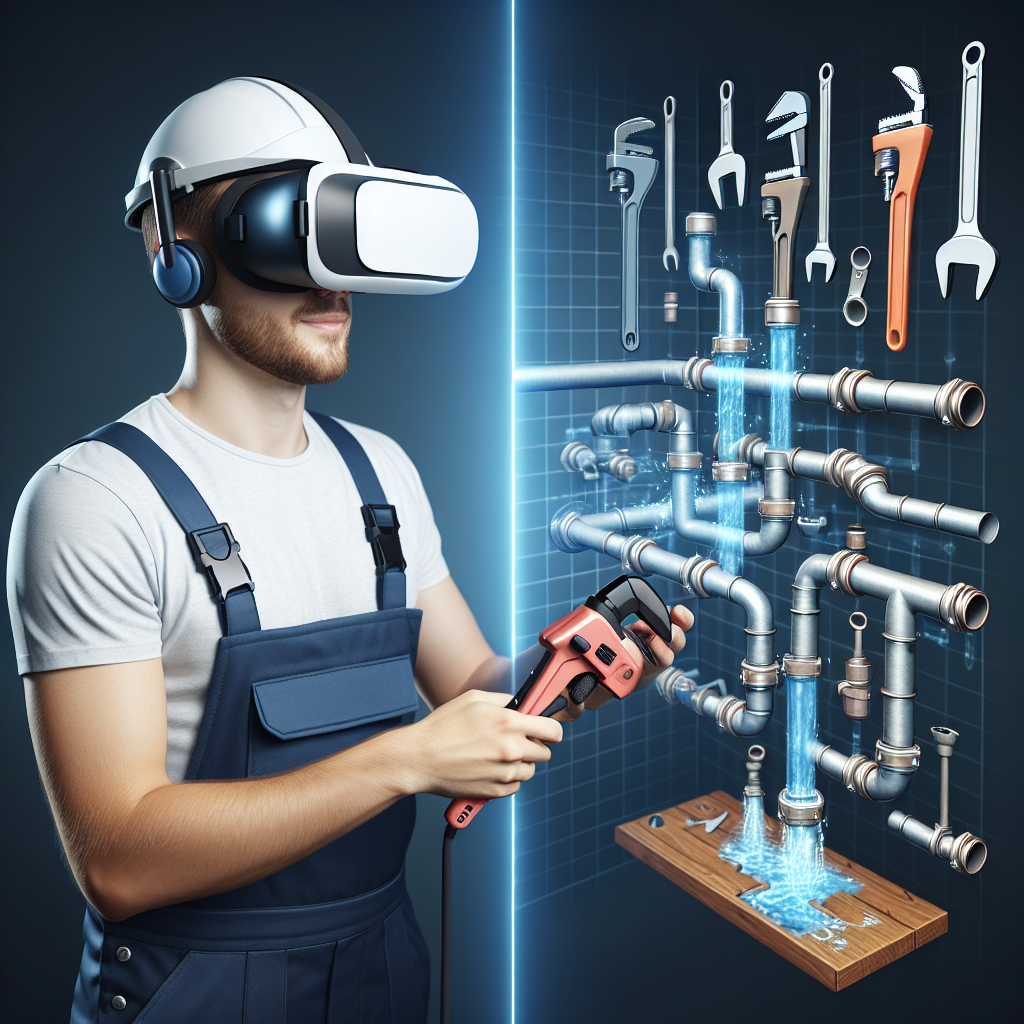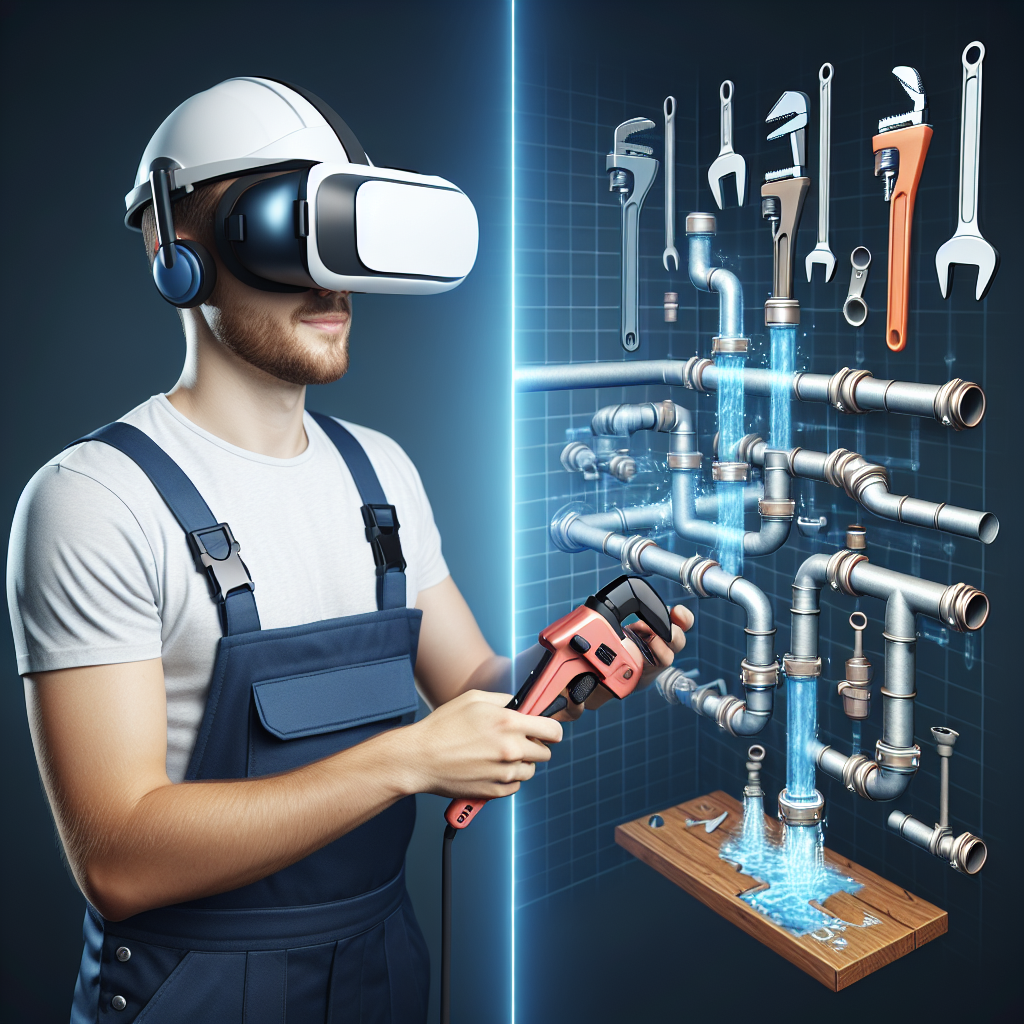Are you curious about how virtual reality training is revolutionizing the field of plumbing? In this article, we will explore the impact of this cutting-edge technology on plumbing training and its potential to transform the industry. Virtual reality training offers an immersive and realistic experience that allows aspiring plumbers to gain hands-on experience without the limitations of traditional classroom or on-the-job training. From increasing efficiency to reducing costs, virtual reality training has the potential to greatly enhance the skills and knowledge of future plumbers. So, let’s take a closer look at the exciting world of virtual reality training in plumbing and the possibilities it holds for the future.
Benefits of Virtual Reality Training
Virtual reality (VR) training has revolutionized the field of plumbing, offering numerous benefits and opportunities for both experienced professionals and aspiring technicians. This advanced technology provides a wide range of advantages, from improved safety to increased confidence and decision-making abilities. Let’s explore the key benefits of virtual reality training in plumbing.
Improved Safety
Safety is a critical concern in plumbing, and traditional training methods often expose technicians to potential risks. Virtual reality training addresses this issue by providing a safe environment where you can learn and practice without endangering yourself or others. By immersing yourself in realistic virtual scenarios, you can improve your understanding of safety protocols, identify hazards, and develop the necessary skills to handle emergency situations effectively.
Realistic Training Environment
One of the most significant advantages of virtual reality training is the ability to simulate real-life plumbing scenarios with remarkable accuracy. Through the use of 3D graphics, audio effects, and realistic physics, VR training creates an immersive experience that closely resembles the challenges you may encounter in the actual job. This realistic environment allows you to practice different techniques, troubleshoot problems, and develop your skills in a controlled yet authentic setting.
Enhanced Learning Experience
Virtual reality training goes beyond traditional classroom lectures or on-the-job training, offering a truly immersive and interactive learning experience. Instead of simply observing or listening, you can actively engage with the virtual environment, working on hands-on tasks, and receiving immediate feedback on your performance. This experiential learning approach enables you to absorb information more effectively, improve knowledge retention, and develop a deeper understanding of the plumbing concepts and techniques.
Cost-Effectiveness
In addition to the advantages related to safety and learning experience, virtual reality training in plumbing also brings significant cost benefits to both individuals and organizations.
Reduced Material Costs
Traditional plumbing training often involves using actual plumbing materials, which can be costly and may result in wastage. With virtual reality training, you can eliminate the need for physical materials as you learn and practice in a virtual environment. This significantly reduces material costs, allowing you to allocate resources to other areas of training or invest in advanced VR technologies.
Time Efficiency
Virtual reality training offers a streamlined and efficient way to acquire plumbing skills. Unlike traditional training methods that may require scheduling and coordinating with multiple parties, VR training allows you to access the virtual environment whenever it suits you. This flexibility saves time, eliminates logistical challenges, and enables you to progress at your own pace. Furthermore, VR training enables you to simulate and complete complex tasks faster than in the real world, optimizing your overall learning efficiency.
Lower Training Expenses
Traditional training methods often involve extensive travel, accommodation, and other associated expenses. With virtual reality training, these costs are significantly reduced or even eliminated entirely. You can attend training sessions remotely, eliminating the need for travel and accommodation expenses. This cost-effectiveness makes virtual reality training an attractive option for organizations and individuals seeking high-quality plumbing education while minimizing financial overheads.

Improved Skills and Performance
The immersive nature of virtual reality training translates into improved skills and performance for plumbing professionals. Let’s explore how VR training enhances your capabilities in the field.
Hands-On Experience
Virtual reality training allows you to gain valuable hands-on experience without the constraints of real-world limitations. Through realistic virtual scenarios, you can practice various plumbing techniques, such as pipe installation, repair, and appliance installation, without the risk of damaging actual infrastructure. This hands-on experience helps you develop muscle memory, refine your techniques, and build confidence in your abilities before working on real projects.
Skill Retention
Retaining skills learned during training is crucial for plumbing professionals, especially in a constantly evolving industry. Virtual reality training enhances skill retention through its immersive and interactive nature. By actively engaging with virtual scenarios, you reinforce your knowledge and skills, improving long-term retention. This ensures that you can perform proficiently in real-life plumbing situations, maintaining a high standard of workmanship and professionalism.
Increased Efficiency
Virtual reality training enables you to enhance your efficiency in plumbing tasks. By practicing in a virtual environment, you can familiarize yourself with new tools, equipment, and technologies, allowing you to execute tasks more efficiently once you transition to real-world applications. This increased efficiency translates into time savings, higher productivity, and improved customer satisfaction, ultimately benefiting both your career and the plumbing industry as a whole.
Reduced Worksite Disruptions
Traditional on-site training can disrupt daily operations, causing delays and inconveniences. Virtual reality training helps mitigate these disruptions, allowing for smoother workflows and minimal worksite interruptions.
Limited Interruptions
With virtual reality training, you can learn and practice plumbing techniques without the need to interrupt ongoing projects or disrupt established worksites. By eliminating the need to physically be present on-site for training, you can focus on your tasks and responsibilities, contributing to a more efficient and uninterrupted workflow. This flexibility is particularly valuable in busy work environments or during critical project phases when disruptions can significantly impact productivity.
Convenience
Virtual reality training provides unparalleled convenience for plumbing professionals. Instead of attending in-person training sessions at a specific location and time, you can access the virtual environment from anywhere, at any time. This flexibility allows you to fit training sessions around your personal schedule, balancing work commitments, and ensuring continuous professional development without sacrificing convenience or compromising project deadlines.
Less Equipment Downtime
On-site training is often associated with equipment downtime and restrictions, limiting the availability of tools and machinery. Virtual reality training alleviates this issue by providing unlimited access to virtual tools and equipment in a risk-free environment. You can practice using different tools, experiment with techniques, and gain confidence working with new equipment without the worry of any downtime or associated costs. This enables you to stay up-to-date with the latest plumbing technologies and methodologies, ensuring you remain competitive in the industry.

Increased Confidence and Decision-Making
Confidence and effective decision-making are critical attributes for successful plumbing technicians. Virtual reality training enhances these capabilities by providing a risk-free environment to hone your skills, solve complex problems, and develop confidence in your abilities.
Risk-Free Environment
Virtual reality training eliminates the fear of making mistakes or causing physical damage. By practicing in a simulated environment, you can make mistakes, learn from them, and refine your decision-making process without any real-world consequences. This risk-free environment fosters experimentation, innovation, and confidence, empowering you to handle challenging plumbing situations with composure and expertise.
Complex Problem-Solving
Plumbing can involve complex problem-solving scenarios, where quick and efficient decision-making is crucial. Virtual reality training prepares you for these situations by exposing you to a wide range of challenging scenarios, such as identifying leaks, resolving drainage issues, or repairing faulty appliances. By repeatedly encountering and resolving complex problems in a virtual environment, you develop the critical thinking and problem-solving skills necessary to tackle real-world challenges confidently.
Confident Plumbing Technicians
The combination of realistic training environments, hands-on experience, and risk-free practice in virtual reality training cultivates confident plumbing professionals. This confidence translates into a positive impact on your overall performance, interactions with clients, and the reputation of both yourself and your organization. By instilling confidence in your abilities, virtual reality training helps you become a trusted and proficient plumbing technician, ensuring continued success in your career.
Applications in Different Plumbing Scenarios
Virtual reality training finds applications in various plumbing scenarios, covering a wide range of skills and techniques. Let’s explore some key areas where VR training proves beneficial.
Pipe Installation and Repair
Virtual reality training provides a valuable platform for learning pipe installation and repair techniques. Through detailed virtual simulations, you can practice tasks such as fitting, connecting, sealing, and troubleshooting pipes, valves, and joints. This enables you to gain a comprehensive understanding of the process, develop the required skills, and refine your techniques before working on real plumbing systems.
Drainage Systems
Drainage system maintenance and repair is another crucial aspect of plumbing. Virtual reality training allows you to familiarize yourself with drainage systems, including clearing blockages, inspecting pipelines, and resolving drainage issues. By immersing yourself in realistic virtual scenarios, you can learn how to identify and address common problems, ensuring effective and efficient operation of drainage systems.
Appliance Installation
Appliance installation, such as water heaters or dishwashers, requires specific knowledge and skills. Virtual reality training offers a controlled and immersive environment to practice appliance installation techniques. By simulating various scenarios, you can learn how to connect plumbing components, ensure proper alignment, and troubleshoot installation issues. This specialized training enhances your competency in appliance installation, enabling you to provide reliable and efficient services.
Adapting to Technological Advances
The plumbing industry is constantly evolving, with new technologies and methodologies being introduced regularly. Virtual reality training helps professionals adapt to these technological advancements, ensuring they remain at the forefront of the industry.
Integrating Virtual Reality Training
By integrating virtual reality training into existing education and training programs, plumbing professionals can stay updated with the latest industry developments. Delivering training through virtual reality platforms allows for seamless integration of new techniques, tools, and technologies, ensuring that professionals are equipped with the necessary skills to tackle contemporary plumbing challenges confidently.
Developing Customized Simulations
Virtual reality training enables the development of customized simulations tailored to specific plumbing scenarios and challenges. By creating realistic virtual environments that reflect real-world conditions, organizations can provide targeted training experiences that address their unique requirements. This customization fosters better skill development, advanced problem-solving abilities, and enhanced professional capabilities within the plumbing industry.
Incorporating Augmented Reality
Augmented reality (AR) is another emerging technology that complements virtual reality training in the plumbing industry. By overlaying digital information onto the physical world, augmented reality enhances the real-time decision-making process for plumbing professionals. By integrating augmented reality features with virtual reality training, technicians can gain access to real-time instructions, annotations, and data overlays during practical tasks, further improving their skills and performance.
Addressing Skill Shortages
The plumbing industry is facing a significant shortage of skilled professionals. Virtual reality training plays a crucial role in attracting new talent, training apprentices, and rapidly developing skills.
Attracting New Talent
Virtual reality training offers an appealing and contemporary approach to training, making it more attractive to prospective plumbing technicians. The immersive and interactive nature of VR training appeals to the younger generation, encouraging them to consider plumbing as a viable and rewarding career option. By leveraging virtual reality’s unique capabilities, the industry can attract new talent, ensuring a sustainable and skilled workforce for the future.
Training Apprentices
Apprenticeships are a key component of building a skilled and competent plumbing workforce. Virtual reality training enhances the apprenticeship experience by providing a platform for comprehensive and immersive learning. Apprentices can practice a wide range of tasks, master essential techniques, and acquire valuable experience in a simulated environment that prepares them for real-world challenges. This accelerated learning process helps apprentices progress faster, ensuring a continuous supply of well-trained plumbing professionals to meet industry demands.
Rapid Skill Development
Virtual reality training offers a rapid and efficient skill development pathway for both new and experienced plumbing professionals. By providing personalized and targeted training experiences, VR training enables individuals to enhance their skills at an accelerated pace. This leads to quicker professional growth, improved career opportunities, and a more competent workforce overall. Rapid skill development through virtual reality training is crucial for addressing the current skill shortages in the plumbing industry.
Tracking and Assessing Performance
Tracking and assessing performance is an essential component of effective training and professional development. Virtual reality training provides valuable tools for real-time performance feedback, identification of areas for improvement, and data-driven training approaches.
Real-Time Feedback
Virtual reality training incorporates real-time feedback mechanisms that allow for immediate evaluation of performance. Using this feedback, technicians can adjust their techniques, identify areas for improvement, and refine their skills during the training process itself. This real-time feedback loop provides invaluable insights into performance and ensures ongoing progress towards mastery.
Identifying Areas of Improvement
Virtual reality simulations capture detailed data on individual performance, enabling comprehensive assessments and identification of areas in need of improvement. By analyzing the data gathered during training sessions, instructors and individuals can identify specific technical or procedural deficiencies, allowing for targeted training interventions. This data-driven approach ensures that training efforts are focused on the areas that will have the greatest impact on skill development and overall performance.
Data-Driven Training
Virtual reality training platforms often collect training data, allowing for a data-driven approach to training and professional development. By analyzing trends, patterns, and performance metrics, organizations can gain valuable insights into training effectiveness, individual progress, and skill gaps within their workforce. This data-driven training approach facilitates evidence-based decision-making, ensuring continuous improvement and optimization of training strategies in the plumbing industry.
Challenges and Limitations of Virtual Reality Training
While virtual reality training offers numerous benefits, it is important to acknowledge the challenges and limitations associated with this technology.
High Initial Investment
Implementing virtual reality training requires a significant initial investment in hardware, software, and infrastructure. VR headsets, powerful computers, and compatible software are essential components, and the cost of acquiring these technologies can be a barrier for some individuals or organizations. However, it is important to consider the long-term benefits and cost savings that virtual reality training offers, which can outweigh the initial investment over time.
Technical Issues
Virtual reality training relies heavily on technology, and technical issues can sometimes hinder the learning experience. Connectivity problems, software bugs, or hardware malfunctions can disrupt training sessions, leading to frustration and inefficiency. However, advancements in VR technology are continually addressing these challenges, and as the technology matures, technical issues are expected to become less common.
Lack of Physical Interaction
Virtual reality training focuses primarily on visual and auditory stimuli, which may limit the level of physical interaction that can be simulated. Plumbing tasks often require physical exertion, tactile feedback, and determination of real-world forces. While advancements in haptic feedback and simulated physical interactions are being explored, virtual reality currently falls short in fully replicating the physical aspects of certain plumbing tasks.
In conclusion, virtual reality training has a profound impact on the plumbing industry, offering numerous benefits and opportunities for professionals and aspiring technicians alike. From improved safety and realistic training environments to enhanced skills and reduced worksite disruptions, virtual reality training revolutionizes how plumbing education and skill development are achieved. By adopting virtual reality training, the industry can attract new talent, address skill shortages, and adapt to technological advancements in a cost-effective and efficient manner. While challenges and limitations exist, the benefits of virtual reality training in plumbing far outweigh the drawbacks, making it an indispensable tool for the future of the industry.

